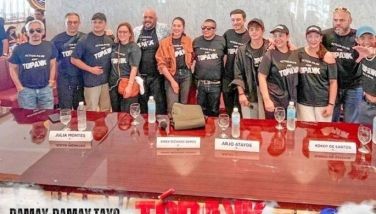The last place a child should be
October 16, 2006 | 12:00am
I've heard about the film "Bunso" some years ago, but I never had the chance to see it. Good thing, the UP Film Institute had it screened once more under the sponsorship of the UP Primemovers. Finally, I was able to see the face behind the controversial documentaries ("Minsan Lang Sila Bata," "Riles," etc.) in person-filmmaker Ditsi Carolino. Employing only two capable cameras, Ditsi teamed up with Nana Buxani in directing "Bunso," which has had made the rounds in local and international film fests and screenings, and collected accolades in the process.
The opening sequence of "Bunso" shows the heavy pouring of rain (which proves to be symbolic and significant throughout the film), after which it shows a group of children sound asleep and squeezed in the only available spaces in an already jam-packed ward floor. These children are child inmates, and this film is about their miserable plight within an impoverished society, as well as their seemingly uncertain fates inside the strange world of Philippine jails.
"Bunso" is set in the world of adult prisons in the Philippines, particularly in Cebu, with all the characters speaking in Cebuano. The documentary has tried to capture the lives of three children, namely Tony, Diosel and Bunso, minors (ages 15 and below) who are detained in jail for stealing and living alongside hundreds of adult inmates. They may have their own "Minor's Ward," but the area, small as it is, is already crowded with over 150 people all distressingly cramped in.
But it's not only the lack of space that they have to deal with. They are also exposed to other elements like the continuous rains and the perpetual leaking roofs, which forced them to seek shelter somewhere else, even if it means they'll have to sleep outside, get chilled to the bone and experience discomfort with the want of sufficient clothing and proper sleeping beds.
They are also burdened with the pressure to survive. Save for the other inmates who try to look after them and protect them from the harsh realities of prison life, they are forced to take care and feed themselves since they have no one to rely on. One can't help but ask: what about their families? Their families, who laden already with other domestic problems, forget to visit them. This makes me wonder how could parents possibly afford to be separated from their children for long periods of time? Do they resent the presence of their children? Because I, for one, couldn't understand the whole idea that these children are in jail when in the first place, it is their parents who forced them to the streets and eke out a living. These parents have been unable to adequately care for and feed their children. And taking into account these circumstances, I can't put the blame on the kids.
One of the more haunting scenes is the disturbing dialogue between Tisoy/Bunso and his mother who repeatedly promises him that he would be out of jail soon-but to no success. Bunso blames his mother for his condition. On the other hand, the mother blames him back for his misbehavior-the reason why, as she never fails to point out, he has to remain in jail. This particular scene has struck me most and I can't help but empathize with the little boy, who at such a young age already has displayed such adult sensibility-much to the amusement of the older inmates.
Bunso and the other boys, especially Tony, give us an idea of the country's prison system, and that these child-inmates, young as they are, are capable of speaking out their sorrows and joys with child-like innocence at the same time grown-up wisdom. Nevertheless, it is simply horrifying to know that there exists child inmates and that these things have happened out of despair, rebellion, and hunger. The children have been caught between tremendous poverty and the law. Like every other child, they sure want to experience the comforts of life, and yet, staying in jails has robbed them of every single opportunity to enjoy their childhood, needs, and wants.
The film ends with one of the boys singing a Cebuano song, which for them rightfully describes their condition. In the ending credits, we would learn that two of the main characters in the film (Tony and Bunso) had languished and died in jail, never fully experiencing the childhood that they deserve.
"Bunso" is a moving story, and on a personal level, it could be sad and upsetting but totally real. By far, it is one of the best that I've ever seen under this genre. I haven't seen much observational cinemas to compare the film with, but just the same, I was impressed by the director's unprecedented access to the prison, the inmates, the rooms, structures, amenities, and the rest-how she was able to document everything as natural as possible. It is no easy matter to direct a film wherein you follow the subjects without having them acting different or distracted what with the surrounding cameras, and Ditsi Carolino was somehow able to achieve this feat. Indeed, the film captures in a nutshell what an everyday life would be like for a child inmate who has to deal, among many other things, the poor conditions of an overcrowded jail alongside adult "criminals."
I have enjoyed the film more so because I speak the same language as those kids-being a Cebuano myself. I could say I had an advantage over other viewers because I understood the other conversations, which were not translated in the film, probably because they were of minor significance. Ditsi Carolino's films are said to be recorded "candidly/unobstrusively," wherein events unfold artlessly in front of the camera, with actors seemingly unaware that they are being filmed.
Yes, there are instances, wherein the other people involved (not the main characters) may have behaved a little differently in front of those cameras. The scenes wherein the guards are doing the head-count, the inmates lining up and competing for the food, and participating in activities inside the minor's wards and using the facilities have comments such as "No don't say anymore, because the cameras are rolling and may hear us," "Do behave, there's the camera," or other comments in passing to that effect. Still and all, the film is well-documented and ably directed.
Definitely, the film had caught the attention of many and that the film and its primary goal-that of campaigning for a comprehensive juvenile justice system law-has been credited to have helped in hastening the passage of the Juvenile Justice Bill this year, seven years after the first proposal of such was filed. I hope it continues to draw out a response from the community and the government in the protection and promotion of child rights in the country.
Also, I got this information from visual anthropology professor, Dr. Floro Quibuyen, and from the reactions or questions I received from friends who wanted to get a copy of the film that it is high time for Ditsi to provide viewers full access to her films like having them mass-produced (into CD or DVD copies) and sold to the general public. In this way, viewers can watch the film anytime without worrying about raising funds and making special screenings just to get Ditsi Carolino's films played in the big screen.
With that set-up, a wider audience is being tapped, and the film's lessons will be heard by many. More of us should realize and witness the truth in the lives of people behind bars, especially those of the young detainees. We know Tony, Diosel and Bunso deserved better. Jail is no place for a child-and it is the last place one should be.'
The opening sequence of "Bunso" shows the heavy pouring of rain (which proves to be symbolic and significant throughout the film), after which it shows a group of children sound asleep and squeezed in the only available spaces in an already jam-packed ward floor. These children are child inmates, and this film is about their miserable plight within an impoverished society, as well as their seemingly uncertain fates inside the strange world of Philippine jails.
"Bunso" is set in the world of adult prisons in the Philippines, particularly in Cebu, with all the characters speaking in Cebuano. The documentary has tried to capture the lives of three children, namely Tony, Diosel and Bunso, minors (ages 15 and below) who are detained in jail for stealing and living alongside hundreds of adult inmates. They may have their own "Minor's Ward," but the area, small as it is, is already crowded with over 150 people all distressingly cramped in.
But it's not only the lack of space that they have to deal with. They are also exposed to other elements like the continuous rains and the perpetual leaking roofs, which forced them to seek shelter somewhere else, even if it means they'll have to sleep outside, get chilled to the bone and experience discomfort with the want of sufficient clothing and proper sleeping beds.
They are also burdened with the pressure to survive. Save for the other inmates who try to look after them and protect them from the harsh realities of prison life, they are forced to take care and feed themselves since they have no one to rely on. One can't help but ask: what about their families? Their families, who laden already with other domestic problems, forget to visit them. This makes me wonder how could parents possibly afford to be separated from their children for long periods of time? Do they resent the presence of their children? Because I, for one, couldn't understand the whole idea that these children are in jail when in the first place, it is their parents who forced them to the streets and eke out a living. These parents have been unable to adequately care for and feed their children. And taking into account these circumstances, I can't put the blame on the kids.
One of the more haunting scenes is the disturbing dialogue between Tisoy/Bunso and his mother who repeatedly promises him that he would be out of jail soon-but to no success. Bunso blames his mother for his condition. On the other hand, the mother blames him back for his misbehavior-the reason why, as she never fails to point out, he has to remain in jail. This particular scene has struck me most and I can't help but empathize with the little boy, who at such a young age already has displayed such adult sensibility-much to the amusement of the older inmates.
Bunso and the other boys, especially Tony, give us an idea of the country's prison system, and that these child-inmates, young as they are, are capable of speaking out their sorrows and joys with child-like innocence at the same time grown-up wisdom. Nevertheless, it is simply horrifying to know that there exists child inmates and that these things have happened out of despair, rebellion, and hunger. The children have been caught between tremendous poverty and the law. Like every other child, they sure want to experience the comforts of life, and yet, staying in jails has robbed them of every single opportunity to enjoy their childhood, needs, and wants.
The film ends with one of the boys singing a Cebuano song, which for them rightfully describes their condition. In the ending credits, we would learn that two of the main characters in the film (Tony and Bunso) had languished and died in jail, never fully experiencing the childhood that they deserve.
"Bunso" is a moving story, and on a personal level, it could be sad and upsetting but totally real. By far, it is one of the best that I've ever seen under this genre. I haven't seen much observational cinemas to compare the film with, but just the same, I was impressed by the director's unprecedented access to the prison, the inmates, the rooms, structures, amenities, and the rest-how she was able to document everything as natural as possible. It is no easy matter to direct a film wherein you follow the subjects without having them acting different or distracted what with the surrounding cameras, and Ditsi Carolino was somehow able to achieve this feat. Indeed, the film captures in a nutshell what an everyday life would be like for a child inmate who has to deal, among many other things, the poor conditions of an overcrowded jail alongside adult "criminals."
I have enjoyed the film more so because I speak the same language as those kids-being a Cebuano myself. I could say I had an advantage over other viewers because I understood the other conversations, which were not translated in the film, probably because they were of minor significance. Ditsi Carolino's films are said to be recorded "candidly/unobstrusively," wherein events unfold artlessly in front of the camera, with actors seemingly unaware that they are being filmed.
Yes, there are instances, wherein the other people involved (not the main characters) may have behaved a little differently in front of those cameras. The scenes wherein the guards are doing the head-count, the inmates lining up and competing for the food, and participating in activities inside the minor's wards and using the facilities have comments such as "No don't say anymore, because the cameras are rolling and may hear us," "Do behave, there's the camera," or other comments in passing to that effect. Still and all, the film is well-documented and ably directed.
Definitely, the film had caught the attention of many and that the film and its primary goal-that of campaigning for a comprehensive juvenile justice system law-has been credited to have helped in hastening the passage of the Juvenile Justice Bill this year, seven years after the first proposal of such was filed. I hope it continues to draw out a response from the community and the government in the protection and promotion of child rights in the country.
Also, I got this information from visual anthropology professor, Dr. Floro Quibuyen, and from the reactions or questions I received from friends who wanted to get a copy of the film that it is high time for Ditsi to provide viewers full access to her films like having them mass-produced (into CD or DVD copies) and sold to the general public. In this way, viewers can watch the film anytime without worrying about raising funds and making special screenings just to get Ditsi Carolino's films played in the big screen.
With that set-up, a wider audience is being tapped, and the film's lessons will be heard by many. More of us should realize and witness the truth in the lives of people behind bars, especially those of the young detainees. We know Tony, Diosel and Bunso deserved better. Jail is no place for a child-and it is the last place one should be.'
BrandSpace Articles
<
>
- Latest
- Trending
Trending
Latest
Trending
Latest
Recommended






















